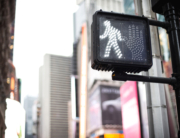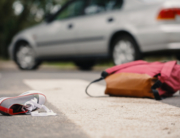Yes, a pedestrian can be at fault for an accident with a car.
How can a pedestrian be liable for an accident?
Pedestrians do not always have the right of way. Pedestrians have a duty of care to keep themselves and other road users safe.
They must pay attention to their surroundings, follow traffic and safety signals, and exercise caution when crossing streets. This means they cannot cross the road outside of a crosswalk and expect a car to stop, or step out in front of a car just because they are in a crosswalk.
If they breach their duty of care and thereby cause an accident, they can be at fault.
When is a driver liable for a car accident?
Drivers have a duty of care to follow the traffic and safety laws and to drive cautiously, especially when they are in areas in which there are likely to be pedestrians.
If a driver is, for example, following all the traffic and safety laws and paying attention to the road, the driver is not at fault when a pedestrian runs out from between parked vehicles and the driver does not have time to stop.
However, if the driver did have time to stop or did not see the pedestrian because he was distracted, he could be liable.
Drivers can also be liable if they refuse to yield to pedestrians in a crosswalk (e.g., when making a right turn on red) or were disobeying laws (e.g., speeding, texting, driving while intoxicated, etc.)
Can a driver sue a pedestrian who causes an accident?
Yes, if the pedestrian’s negligence caused the accident.
Consider the following: a driver is following all applicable traffic and safety laws. An intoxicated pedestrian suddenly rushes out into the street in front of the car. The driver swerves to avoid hitting the drunk pedestrian, and instead, crashes into a light pole. The car is totaled and the driver is injured. The driver can sue the pedestrian for his injuries and property damage.
Can I still recover compensation even if I contributed to the accident?
Yes. Florida follows the pure comparative fault rule to apportion the damages in claims that involve some negligence on both sides. Let us consider the example above; let us change the facts and say that the driver was going 10 miles an hour over the speed limit. Because he was speeding, he was unable to avoid hitting the pedestrian.
The investigator found the driver to be 10 percent at fault and the pedestrian to be 90 percent at fault. The pedestrian’s total claim was $50,000. The pedestrian would be liable for 90 percent of the $50,000 in damages, which comes to $45,000. The driver would owe her $5,000. However, if the driver also suffered injuries, the pedestrian would be liable for 90 percent of those costs.
If you have been injured in a pedestrian accident, the lawyers at the Montero Law Center can help. Call us today at 954-767-6500 to set up your free, no obligation consultation.
 English
English  Español
Español 



